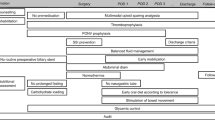Abstract
Introduction
Pancreaticoduodenectomy (PD) is a highly complex operation with high rates of morbidity and significant potential for perioperative mortality. Enhanced recovery after surgery protocols following PD aim to standardize post-operative clinical pathways in an effort to decrease surgical stress, minimize practice variation, and accelerate postoperative recovery. We reviewed current evidence and provide recommendations for enhanced recovery after PD protocols.
Methods
Current evidence regarding enhanced recovery after PD were reviewed. Recommendations for enhanced recovery after PD protocols are provided based on evidence and expert opinion.
Results
Key clinical factors required for a enhanced recovery after PD protocol to reduce postoperative complications and promote a faster recovery include patient and provider education, preoperative oral nutrition until 2–3 h prior to surgery, goal-directed intravenous fluid management, early advancement of oral diet, multimodal analgesia, early mobilization, normoglycemia, and early removal of intra-abdominal drains when clinically indicated. A PD specific protocol has been shown to reduce rates of PD-specific and overall complications as well as shorten postoperative hospital length of stay.
Conclusion
The key facilitator to a successful enhanced recovery after PD protocol is careful multi-disciplinary planning with input from all stakeholders. Evidenced-based enhanced recovery protocols have been shown to reduce postoperative morbidity and accelerate postoperative recovery following PD.

Similar content being viewed by others
References
DeOliveira ML, Winter JM, Schafer M, et al. Assessment of complications after pancreatic surgery. Ann Surg. 2006. https://doi.org/10.1097/01.sla.0000246856.03918.9a.
Enomoto LM, Gusani NJ, Dillon PW, Hollenbeak CS. Impact of surgeon and hospital volume on mortality, length of stay, and cost of pancreaticoduodenectomy. J Gastrointest Surg. 2014. https://doi.org/10.1007/s11605-013-2422-z.
Schneider EB, Hyder O, Wolfgang CL, et al. Provider versus patient factors impacting hospital length of stay after pancreaticoduodenectomy. Surgery (United States). 2013. https://doi.org/10.1016/j.surg.2013.03.013.
Lassen K, Coolsen MME, Slim K, et al. Guidelines for perioperative care for pancreaticoduodenectomy: Enhanced Recovery After Surgery (ERAS®) Society recommendations. Clin Nutr. 2012. https://doi.org/10.1016/j.clnu.2012.08.011.
Ji HB, Zhu WT, Wei Q, Wang XX, Wang HB, Chen QP. Impact of enhanced recovery after surgery programs on pancreatic surgery: a meta-analysis. World J Gastroenterol. 2018. https://doi.org/10.3748/wjg.v24.i15.1666.
Lavu H, McCall NS, Winter JM, et al. Enhancing Patient Outcomes while Containing Costs after Complex Abdominal Operation: a randomized controlled trial of the whipple accelerated recovery pathway. J Am Coll Surg. 2019. https://doi.org/10.1016/j.jamcollsurg.2018.12.032.
Amini N, Kim Y, Hyder O, et al. A nationwide analysis of the use and outcomes of perioperative epidural analgesia in patients undergoing hepatic and pancreatic surgery. Am J Surg. 2015. https://doi.org/10.1016/j.amjsurg.2015.04.009.
Merath K, Hyer JM, Mehta R, et al. Use of perioperative epidural analgesia among Medicare patients undergoing hepatic and pancreatic surgery. HPB. 2019. https://doi.org/10.1016/j.hpb.2018.12.008.
Poruk KE, Lin JA, Cooper MA, et al. A novel, validated risk score to predict surgical site infection after pancreaticoduodenectomy. HPB. 2016. https://doi.org/10.1016/j.hpb.2016.07.011.
Kahokehr A, Sammour T, Zargar-Shoshtari K, Thompson L, Hill AG. Implementation of ERAS and how to overcome the barriers. Int J Surg. 2009. https://doi.org/10.1016/j.ijsu.2008.11.004.
Author information
Authors and Affiliations
Corresponding author
Additional information
Publisher's Note
Springer Nature remains neutral with regard to jurisdictional claims in published maps and institutional affiliations.
Rights and permissions
About this article
Cite this article
Hamad, A., Pawlik, T.M. & Ejaz, A. Guide to Enhanced Recovery for Cancer Patients Undergoing Surgery: Pancreaticoduodenectomy. Ann Surg Oncol 28, 6965–6969 (2021). https://doi.org/10.1245/s10434-021-09717-1
Received:
Accepted:
Published:
Issue Date:
DOI: https://doi.org/10.1245/s10434-021-09717-1




